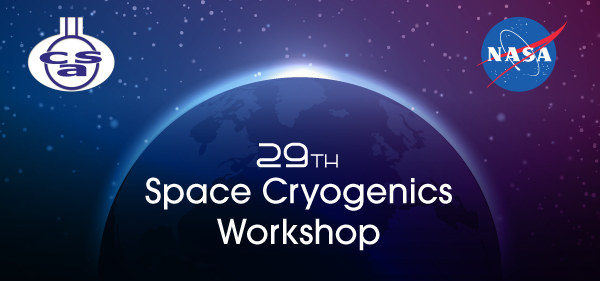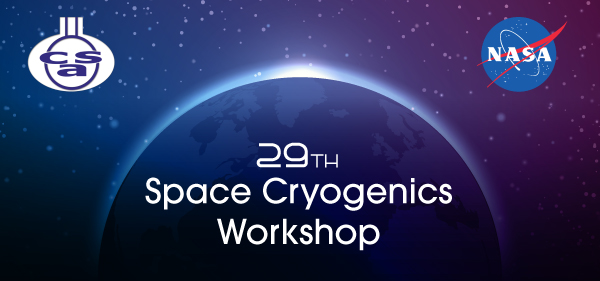 During a year filled with uncertainty, many were worried about the effects of the pandemic on CSA’s biennial Space Cryogenics Workshop (SCW). After much consideration and effort, we are pleased to report the successful execution of our first – and hopefully only – virtual SCW. Hosted virtually on the Remo® online platform on November 15 and 16, the event was two days of presentations, networking and reconnecting with colleagues and friends. Each of the two days was broken up into two groups of presentations, beginning and ending with networking opportunities in Remo’s virtual conference room. Co-chairs Amir Jahromi and Mark Kimball moderated all four sessions while CSA’s Megan Galeher and Tate Paglia – executive director and editor, respectively – worked as administrators for the sessions. Sponsors included Lake Shore Cryotronics, XMA, Lihan, Eta Space and Ability Engineering Technology, all CSA Corporate Sustaining Members.
During a year filled with uncertainty, many were worried about the effects of the pandemic on CSA’s biennial Space Cryogenics Workshop (SCW). After much consideration and effort, we are pleased to report the successful execution of our first – and hopefully only – virtual SCW. Hosted virtually on the Remo® online platform on November 15 and 16, the event was two days of presentations, networking and reconnecting with colleagues and friends. Each of the two days was broken up into two groups of presentations, beginning and ending with networking opportunities in Remo’s virtual conference room. Co-chairs Amir Jahromi and Mark Kimball moderated all four sessions while CSA’s Megan Galeher and Tate Paglia – executive director and editor, respectively – worked as administrators for the sessions. Sponsors included Lake Shore Cryotronics, XMA, Lihan, Eta Space and Ability Engineering Technology, all CSA Corporate Sustaining Members.
After a welcome ceremony including a “Hello” from Laurie and Werner Huget, CSA’s past stewards, Day 1’s first group was “Missions I,” focusing on ongoing, upcoming and future space missions. Presentations from Peter Shirron, Michael DiPirro, Jason Hartwig, William Notardonato and Ramaswamy Balasubramaniam, shared their work: “Performance of the 3-Stage ADR on the Resolve Instrument on the X-Ray, Spectroscopy and Imaging Mission,” “Finding and Fixing a Small Low Temperature Leak – A Case Study on XRISM/Resolve,” “The Reduced Gravity Cryogenic Transfer Project,” “Development of Cryogenic Propellant Depots for Sustainable Space Exploration,” and “Gravitational Effects on Liquefaction Systems for Lunar and Mars exploration,” respectively.
After a brief networking break, the next session – “Cryocoolers” – featured presentations from Roel Arts, Keisuke Shinozaki, and Shuang Tang. The topic of cryocoolers for space applications was discussed, including developments, testing and advancements of both soon-to-be-launched or currently in-orbit instruments. Presentations, in order of speaker, were “LPT6510 Development up to Flight Model,” “Cooling Performances of Joule Thomson Coolers with Straight Heat Exchangers for Space Science Missions,” and “Energy Sensitivity of Carrier Transport and Scattering: A New Path for Cryogenic Electronics and Solid State Cryo-Coolers.”
After a short lunch break, part two of Day 1 focused on “Experimental Cryogenics.” Scott Courts, Wesley Johnson and co-chair Mark Kimball discussed “Stability of Cernox Temperature Sensors Stored at Room Temperature Over a 29 Year Period,” Summary of Testing Results for the Structural Heat Intercept, Insulation, and Vibration Evaluation Rig,” and “Highly Sensitive Investigation of a Helium Leak in a Cryogenic Valve,” respectively.
Then, Adam Swanger, Tom Conboy, Joydip Mondal and Alok Majumdar covered “Cryogenic Fluids I.” In order of speaker, presentations were: “Passive Cooling in Aerogel-Based Insulation Systems for Liquid Hydrogen Upper Stage Launch Vehicle Tanks,” “Development of a Hybrid Screen Channel Liquid Acquisition Device for Reliable Microgravity Transfer of Cryogenic Fluids,” “Numerical Investigation of the Flow-field Due to Oscillating GN2-LN2 Interface in Presence of Ultrasound” and “Numerical Modeling of No Vent Filling of a Cryogenic Tank with Thermo-dynamic Vent System Assisted Injector.”
Day 2 began with another welcome session and networking before the presentations of “Missions II” began. Mike Meyers and Wesley Johnson presented their works entitled, “Recent Concept Study for Cryogenic Fluid Management to Support Conjunction Class Crewed Missions to Mars” and “Liquefaction of Cryogenic Fluids for Production and Storage of Commodities on Extra-Terrestrial Surfaces.”
After a short break, “Cryogenic Fluids II” was presented by Mansu Seo, Sam Darr, Matthew Taliaferro, Keerthi Raj Kunnlyoor, Alireza Moradikazerouni, Arpit Mishra and Niklas Weber. Presentations, in order of speaker, were: “Investigation of Line Chill-down Process with Liquid Oxygen in Ground Launch Complex,” “Cryogenic Chilldown Model of Transfer Line with Low-effusivity Coating,” “Control Volume Approach to Cryogenic Transfer Line Chilldown Investigation of Quench Flow Boiling Heat Transfer Correlations for Cryogenic Feedline Chill-down Modeling,” “Computational Study of Natural Convection in Pressurized Cryogenic Tanks,” “Shearing Jets from an Interacting Bubble-pair in the Cryogenic Environment,” and “Vapor Bubble Growth in Liquid Methane due to Pressure Reduction in a Microgravity Environment.”
After lunch, part two of Day 2 began with “Propulsion.” Speakers included Seungwhan Baek, Lokesh Kumar Meena, Feroz Khan, Dylan Sagmiller and Kishan Bellur who gave their presentations entitled: “The Effect of Spray Cooling During the Cryogenic Liquid Pressurization with Helium,” “Performance parameter estimation for HTS-magnet based Magneto Plasma Dynamic Thrusters (MPDT),” “Cryogenic System Design for High-Temperature Superconducting Magnets in Applied-Field Magnetoplasmadynamic Thrusters,” “Numerical Modeling and Design of a Gaseous Propellant Acquisition System for the Triton Hopper,” and “Mass Accommodation Coefficient of Cryogenic Propellants: A Cryo/Neutron Study.”
Following these presentations, “Superconductivity in Space Cryogenics” was addressed. Speakers Feroz Khan and Sonja Schlachter presented “Magnetohydrodynamic Enhanced Entry System for Space Transportation (MEESST) as a Key Building Block for Future Exploration Missions” and “High-Temperature Superconductor Harness for Cryogenic Instruments on Satellites,”
respectively.
We thank all our sponsors, presenters, co-chairs, moderators and, most importantly, attendees for making a virtual Space Cryogenics Workshop just as enriching and rewarding as any in-person event. We look forward to seeing you face-to-face in 2023! A full list of presentations, including abstracts, can be found at spacecryogenicsworkshop.org/agenda. ■
[Source: Cold Facts Vol 37 No 6]



